Journeys in STEM
Transitioning through academic levels to a career is a journey. The AccessSTEM and AccessComputing projects, both led by the University of Washington (UW) and funded by the National Science Foundation (NSF), help students with disabilities toward careers in science, technology, engineering, and mathematics (STEM), with AccessComputing more narrowly focused on computing fields. DO-IT—which stands for Disabilities, Opportunities, Internetworking, and Technology— partners with the UW College of Engineering and Department of Computer Science and Engineering to undertake these projects that promote the success of individuals with disabilities in college, graduate school, and careers.
In AccessSTEM and AccessComputing hundreds of individuals with disabilities have participated in activities that increase STEM interest and success through critical junctures (e.g., high school graduation, enrollment in college) and transitions (e.g., military service to college, 2-year to 4-year school, undergraduate to graduate school, college to career). Participants engage in activities that include STEM internships, mentoring, self advocacy practice, peer support, role-play interactions with faculty and employers, and career opportunities.
The AccessSTEM critical junctures model (see Figure below) identifies key steps that lead to the success of students with disabilities in STEM careers. Based on a literature review and over twenty years of practice in the field, the model also highlights interventions (e.g., mentoring, research experiences, technology access) that support students on their journeys.
The AccessSTEM/AccessComputing/DO-IT Longitudinal Transition Study (ALTS) measures success in taking critical steps toward STEM careers of participants with disabilities in activities sponsored by AccessSTEM and other projects sponsored or co-sponsored by the DO-IT Center at the UW. To date, more than 300 students with a wide range of disabilities participate in this ongoing study.
In ALTS, participants are asked to report key academic and work-based achievements. They also identify the DO-IT activities they participated in and rate the value of specific activities. Researchers record the “on track” status of respondents as they progress through critical junctures that lead to degrees and careers in STEM. As this database grows, it increasingly reveals the long-term impact of DO-IT’s program activities. It quantifies the relative importance of activities for achieving positive postsecondary outcomes. More information about ALTS and its current results are available at www.uw.edu/doit/2011-report-accessstemaccesscomputingdo-it-longitudinal-transition-study-alts.
Ultimately, understanding the STEM journeys of students with disabilities requires that we hear their stories, understand their struggles, and reflect on their experiences. The following section of this book shares essays about journeys in STEM from participants in AccessSTEM, AccessComputing, and other DO-IT programs.
